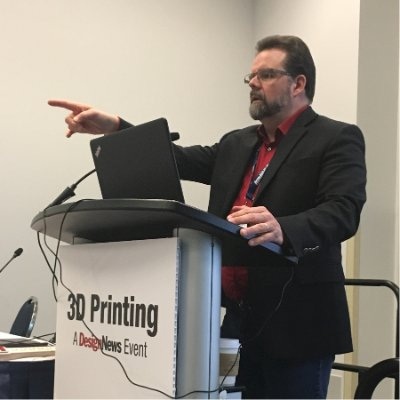To Understand If 3D Printing Works for You, Educate Yourself
The best way to understand the benefits of 3D printing is to redesign a product to take advantage of the process, experts say.
February 28, 2018

3D printing won’t help your manufacturing process unless you educate yourself and understand your own products, experts will say at the upcoming Cleveland Advanced Design & Manufacturing Expo.
“You have to put in the effort,” Jack Heslin, founder of J3D Services, told Design News. “You need to look at your components and study them in light of additive technologies. What are your products’ dimensional qualities? What are their stresses, loads and thermal properties? You first need to redesign your components to take advantage of 3D printing, and only then can you assess whether it will help you or not.”
Heslin, who will be joined by a panel of three other experts at the expo, told us that many manufacturers don’t bother to do the hard work up front, and because of that, never fully understand the potential benefits.
“The wrong way to do it is to look at something you’ve made for many years with few modifications, and ask, ‘Can we 3D print this?’” Heslin said. “The answer from a purely technical perspective is probably going to be yes. But if you do it that way, it’s probably going to cost more money. And you’re probably not going to get any advantage out of it.”
Heslin contends that the key to getting benefits from 3D printing lies in the redesign. He cited the example of Optisys LLC, a maker of micro-antenna products for aerospace and defense applications. Using a 3D-printed metal antenna, he said, Optisys recently reduced a product’s part count from 100 to one, cut its weight by 95%, dropped lead time from 11 months to two, and slashed production costs by 20-25%. He also pointed to the recent successful test of a new 3D-printed advanced turboprop aircraft engine from GE. 3D printing reportedly enabled GE designers to combine 855 separate assemblies into 12, allowing engineers to shave off more than 100 pounds of mass and improve fuel burn by as much as 20%.
|
Jack Heslin of J3D Serices: You first need to redesign your components to take advantage of 3D printing, and only then can you assess whether it will help you or not.” (Source: J3D Services) |
The key to realizing such advantages is to examine the entire process that underlies the product, Heslin said. That includes the initial concept, CAD design, prototyping, production, jigs, fixtures, tooling, and support. “If you look at each one of these steps in the manufacturing process, there’s probably going to be a way in which additive manufacturing will provide a benefit,” he said.
Unfortunately, many manufacturers are unaware of the different types of 3D printing processes, and the ways they might help, Heslin added. Many hear the term “3D printing” and believe it’s a single process. “There are seven distinct 3D printing technologies as defined by ASTM (American Society of Testing and Materials), and those technologies can have remarkably little in common,” he said. “So if you’re looking at one 3D printing technology and it doesn’t work for you, it doesn’t mean the others won’t work for you.”
Many manufacturers never do a fair assessment because doing so can be difficult and time consuming, Heslin said. Large manufacturers with big engineering staffs are more likely to be able to afford to create a task force and investigate the matter. “If you have 40- or 50-person manufacturing company, and everyone’s job is crucial to the bottom line, it’s not going to be easy to take the time to do this,” Heslin said.
Still, Heslin urged manufacturers to consider 3D printing, even if it doesn’t seem to be obvious fit at first glance. “You have to start, whether you know a lot or a little,” he told us. “If you don’t, your competitor might.”
Read More Articles on 3D Printing
3D Printing Paves Way for Fabrication of Devices INside the Body
10 3D Metal Printing Companies You Should Know
Olympics Luge Team Builds a Better Sled with Additive Manufacturing
3D Printing of Metal Parts Is on the Rise, Expert Says
Senior technical editor Chuck Murray has been writing about technology for 34 years. He joined Design News in 1987, and has covered electronics, automation, fluid power, and auto.
CAPITALIZING ON THE CHANGING DYANMICS OF 3D PRINTING |
About the Author(s)
You May Also Like





